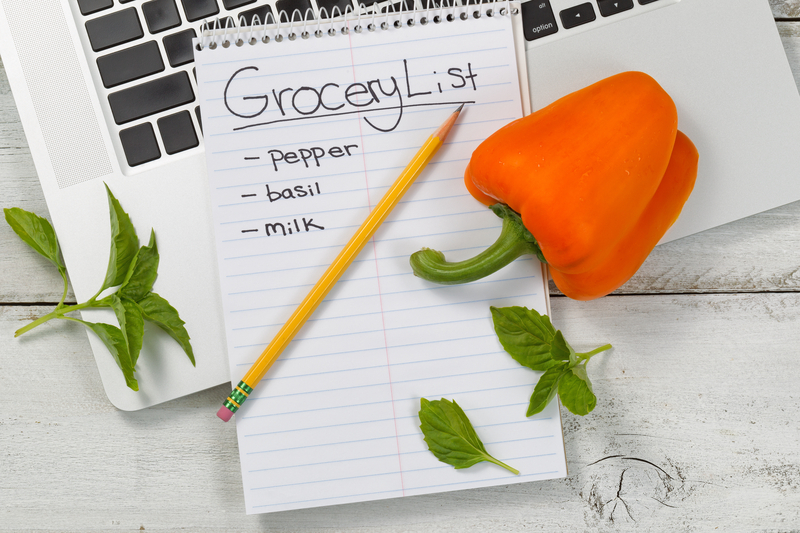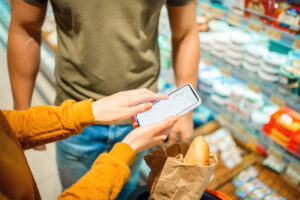The coronavirus pandemic had an almost immediate impact on how U.S. consumers shopped for groceries. By the end of May, reports Russell Redman, a survey by Inmar Intelligence found, “More Americans [were] shopping online for groceries and [were] doing it more often since the onset of the coronavirus pandemic. … Of more than 300 U.S. consumers polled, 78.7% reported shopping online for groceries after the COVID-19 outbreak, up 39% from before the pandemic. … What’s more, 56.7% of respondents said they shop for groceries online more often now than before the pandemic.”[1] Jim Hertel, senior vice president of analytics at Inmar, told Redman, “This trend is likely to continue even as restrictions are lifted, as shoppers have grown accustomed to this routine. Today’s shoppers expect convenient and personalized engagements in every interaction, across all touch points. Retailers and brands must work to seamlessly deliver meaningful experiences that delight shoppers and drive loyalty.” Hertel isn’t alone in his belief that consumers are settling in to dual channel shopping patterns. Bridget Goldschmidt (@BGoldschmidtPG), managing editor of Progressive Grocer, writes, “According to the ‘2020 U.S. Online & In-Store Grocery Shopping Study’ from the Retail Feedback Group (RFG), which offers a broad spectrum of research, consumer insight and consulting services, dual-channel shopping has become much more common amid the coronavirus pandemic, especially among younger consumers.”[2]
Settling in to shopping routines
Back in June, “Chicory released the results of a new grocery consumer research study, quantifying the impact of the coronavirus on online grocery usage. The study shows that consumers are both shopping online for groceries more frequently and also checking out with bigger baskets.”[3] According to the report, “The data indicates that consumers may be replacing their regular in-store grocery trips with online orders.” Reporting on a later Chicory survey, Jessica Dumont (@JLDumont6) notes, “Online grocery buying is stabilizing among consumers but remains higher than it was pre-pandemic. … About 60% of respondents bought groceries online in July, compared with 63% in April and 53% in January of this year. … About 43% of shoppers said they place online grocery orders once a week, and 33% say they order online once a month. From Q1 to Q2, when Chicory first conducted its survey, the number of people who completed online grocery purchases weekly or more grew by 17%.”[4]
Dumont explains, “The report from Chicory notes that many shoppers have settled into a ‘new normal’ routine with online grocery shopping. The panic-buying crazy that drove so many shoppers online in April tapered off a bit based on July results, but the firm said the number of people who bought online in the past 60 days is still 12% higher than before the pandemic. And all indications are that online grocery shopping will remain well above pre-pandemic levels for the foreseeable future.” Goldschmidt notes that dual channel shopping is becoming more common for all age groups, but younger shoppers were the most likely to shop dual channel. She explains, “Overall, 50% of in-store supermarket shoppers in [May] also ordered groceries online, the [RFG] report found, adding that this tendency was even more common among Gen Z (66%) and Millennial (61%) consumers, and, to a lesser degree, Gen X (52%), trailed by Boomers (37%) and the Silent Generation (38%).” The fact that younger generations were more likely to shop via dual channel means that trend is likely to continue into the future. Simultaneously, Dumont notes, “Shoppers are becoming more savvy with their online shopping and are going to retailers that may better suit their needs.”
Will dual channel shopping persist?
Hillary Reeves (@hillreeves), vice president of marketing at Chicory, is less sanguine about the long-term viability of online grocery shopping than many other analysts. Why? Her logic is pretty simple. She notes that what drove shoppers to buy groceries online wasn’t convenience, or personalization, or the rise of omnichannel shopping. What caused the rise in online shopping was necessity. She explains:
“What made online grocery adoption actually happen? A pandemic. Fear and an attempt to be socially responsible led consumers to begin using online grocery at rates that were completely unpredicted and more impactful than any marketing campaigns of the past. We misunderstood what consumers wanted from online grocery. It wasn’t drones or driverless cars to ensure quicker delivery. It wasn’t couriers delivering groceries straight to the fridge in case they couldn’t be home to receive the order. It wasn’t a VR experience that made them feel like they were walking the aisles. And, though consumers will often say this, it might not even have been the fear of someone else picking out the right bananas. What got consumers to adopt online grocery shopping was a scenario that made it necessary.”[5]
If necessity is what drove consumers to buy groceries online, Reeves believes consumers will likely stop buying online once the need to do so ends. She writes, “Online grocery does not need to be convenient, fun or filled with robots. Perhaps those could be means to an end, but what online grocery has to do is fulfill basic needs. Therefore, it has to be reliable, quick, affordable and flexible. Without these essentials, consumers will never thoroughly adopt online grocery into their shopping habits, and it will remain a backup plan for in-person shopping.” Inmar’s Hertel isn’t quite so pessimistic. “I think a substantial portion of them will remain online grocery shoppers,” he states. “But there are two really important aspects that will impact that behavior. The first is the customer experience. … That’s going to be really, really important. … Based on our own experiences, I give the industry probably a C or C-plus overall from that standpoint. The second thing … is that a significant number of those shoppers really want to understand in-stock position. Is that product in the store? Is it available to me online? And if it’s not available now, either in store or online, please let me know when I can order and receive. That is a step up in terms of consumer requirements and consumer demands. It’s probably a function of the environment we’re in right now. But you can just start to see consumer expectations climbing.”[6]
Concluding thoughts
Although online grocery shopping is here to stay, whether consumers remain persistent online shoppers remains to be seen. David Bishop, a partner with Brick Meets Click, insists consumers are becoming more discerning about where they’re shopping online for groceries. “In the early stages of COVID, it was all about availability and can I place an order online?” he said. “Now, what we’re seeing is that as out-of-stocks continue to come down, albeit still at elevated levels, customers are now looking at all aspects of the experience, from the quality of the products to the completeness of the order to, how easy is it?”[7] The bottom line is this: Grocers will be required to offer excellent dual channel customer experiences if they want to secure consumer loyalty in the years ahead.
Footnotes
[1] Russell Redman, “Nearly 80% of U.S. consumers shopped online for groceries since COVID-19 outbreak,” Supermarket News, 27 May 2020.
[2] Bridget Goldschmidt, “Dual-Channel Grocery Shopping Surges,” Progressive Grocer, 30 June 2020.
[3] Staff, “Chicory Looks At Impact Of Coronavirus On Online Grocery Usage,” The Shelby Report, 26 June 2020.
[4] Jessica Dumont, “Shoppers settle into online grocery routines,” Grocery Dive, 10 August 2020.
[5] Hillary Reeves, “What do consumers want from online grocery? The answer is simpler than you think,” Grocery Dive, 30 June 2020.
[6] Michael Browne, “Is the new online grocery shopper here to stay?” Supermarket News, 30 June 2020.
[7] Dumont, op. cit.





